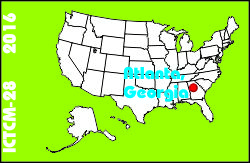
Electronic Proceedings of the Twenty-eighth Annual International Conference on Technology in Collegiate MathematicsAtlanta, Georgia, March 10-13, 2016Paper A040
Real Polynomials with a Complex Twist |
Michael WarrenTarleton State University mwarren@tarleton.edu | John GreshamTarleton State University jgresham@tarleton.edu | Bryant WattTarleton State University wyatt@tarleton.edu |
| Click to access this paper: |
ABSTRACT
Student appreciation of a function is enhanced by understanding the graphical representation of that function. From the real graph of a polynomial, students can identify real-valued solutions to polynomial equations that correspond to the symbolic form. However, the real graph does not show the non-real solutions to polynomial equations. Instead of enhancing studentsí idea of a function, the traditional graph implies a clear disconnect from the symbolic form. In order to fully appreciate the Fundamental Theorem of Algebra, and the non-real solutions of a polynomial equation, traditional graphs are inadequate. Since the early 20th century, mathematicians have tried to find a way to augment the traditional Cartesian graph of a polynomial to show its complex counterpart. Advancements in computer graphics allow us to easily illustrate a more complete graph of polynomial functions that is still accessible to students of many different levels. The authors will demonstrate a method using modern 3D graphical tools such as GeoGebra to create dynamic visualizations of these more complete polynomial functions.Keyword(s): GeoGebra
